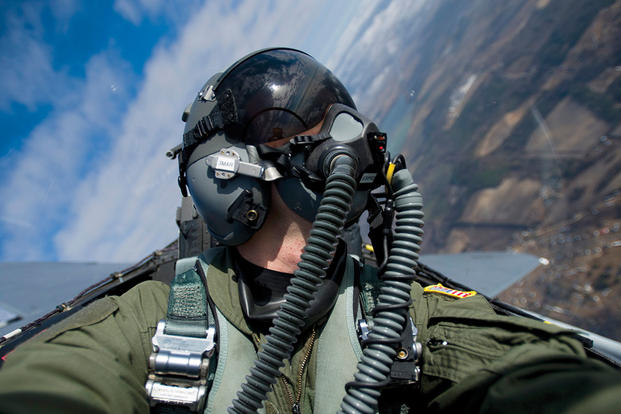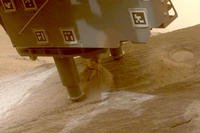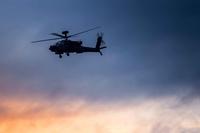FARNBOROUGH, England -- Cobham, whose breathing sensor system, VigilOX, has been helping monitor U.S. Navy pilots while in flight for months, has a contract to develop a new system to predict and respond to pilots' oxygen needs.
The company on Tuesday announced it was recently awarded a contract by the Pentagon's foreign comparative testing, or FCT, program to begin developing an autonomous pilot life support system called SmartFLO.
Officials said the system -- believed to be the world's first sensor-driven breathing regulator -- will monitor and "automatically adjust oxygen dosed to the pilot" based on real-time pilot movements or conditions during flight.
"Cobham's SmartFLO electronic breathing regulator will autocorrect flow to proactively pre-empt the onset of hypoxia-like symptoms if unexpected changes in cabin pressure or excessive expired carbon dioxide levels in the pilot's breathing are detected to better protect the pilot," according to a release.
Related content:
- Congress Wants Air Force, Navy to Solve Pilot Physical Episodes Now
- Pilots 'Not Making Things Up,' Air Force Says of 'Hypoxia' Incidents
- Military.com Farnborough Airshow Coverage
"VigilOX is sort of the first step. It's a data collection tool, [but] we don't envision VigilOX being a long-term solution [for pilots]," said Rob Schaeffer, product director of environmental systems at Cobham Mission Systems. Military.com spoke with Schaeffer during the Farnborough Airshow here this week.
"What we're planning on doing is taking VigilOX, some of the sensors in VigilOX, and we're going to integrate them into, for example, regulator oxygen concentrators, or back-up oxygen systems, so that all the components can communicate with one another and respond to the changing needs of the pilot during flight," he said of the "predict and protect" custom capability.
Delivery of the regulator is anticipated in 2019, officials said.
While a contract amount was not specified, Schaeffer said work so far for the project has been funded through the company.
Over the next few years, teams will update the system with an underlying algorithm called the Auto Response Guided Oxygen System, or ARGOS. Officials said the system "will have the ability to control the entire pilot oxygen system from air source to mask" through the algorithm, which is continuously communicating, synching and connecting with the pilot.
The VigilOX system is currently gathering pilot data as Cobham experts help the Navy and NASA analyze the information.
"We've been flying an increased amount on F-18 [Super Hornets] and T-45 [Goshawks] .. .[of which] the Navy has ordered several systems … to collect data with their test squadron," Schaeffer said of the leading Naval Air Systems Command team. The service began using VigilOX in February.
"This is data that's never been collected before," he said. "Everyone is trying to figure out what to do with that information."
The need for the system has grown because the Defense Department has been unable to find a root cause for pilots experiencing hypoxia-like symptoms, including disorientation, shortness of breath, confusion and wheezing, among other manifestations.
As experts and physiologists review the program, the T-45s and F-18s will continue flying with VigilOX through the summer, Schaeffer said.
The sensors monitor what a pilot may endure in real time: breathing rate, pressure flow, cabin pressure, temperature and humidity, among other factors.
Cobham also makes the CRU-123 solid-state oxygen monitor, which has been incorporated into nearly all Navy T-45 aircraft.
"The sensors are working as designed. [Originally designed for the Air Force], the VigilOX system was customized to monitor the Navy-use case because most pilots in the service fly with more than 90 percent oxygen concentration at all times," Schaeffer said.
"We've customized our VigilOX system for the Navy-use case because the Navy-use case is different than the Air Force-use case," he added. "And by that I mean the Navy flies 93, 94 percent oxygen at all times whereas the Air Force is a dilution system, where they're diluted the oxygen depending on what altitude they're flying at."
The Air Force is also currently testing VigilOX in its original configuration, Cobham staff said.
"But a regulator is a regulator is a regulator," Schaeffer said, hinting at the progress SmartFLO and ARGOS will make.
Cobham will expand VigilOX under a joint FCT program with Elbit Systems, which will help define a better performance picture when constructing ARGOS.
VigilOX and Elbit Systems' Canary, a real-time pilot health monitoring system, will better capture data about a pilot's blood flow, the release said.
"The combined data will paint a more complete picture of what is happening to the pilot during extreme flight conditions," it said. "Cobham will develop an algorithm to drive the regulator to increase or decrease oxygen dose based on sensor inputs."
--Editor's note: This story has been corrected to show that the VigilOX sensor was originally designed for the Air Force and customized for the Navy.
-- Oriana Pawlyk can be reached at oriana.pawlyk@military.com. Follow her on Twitter at @Oriana0214.










